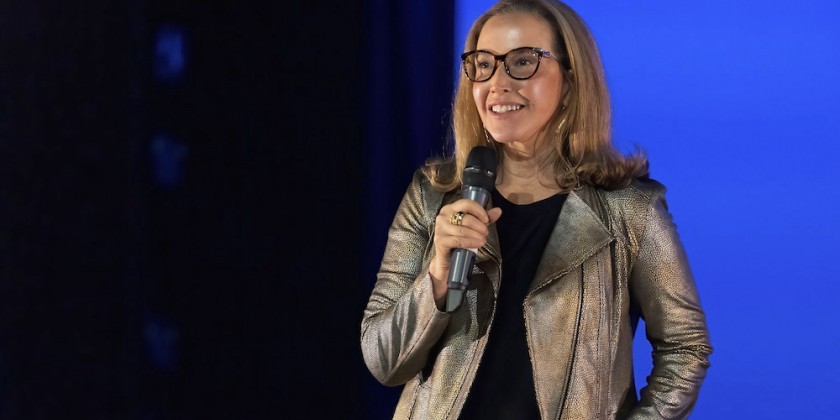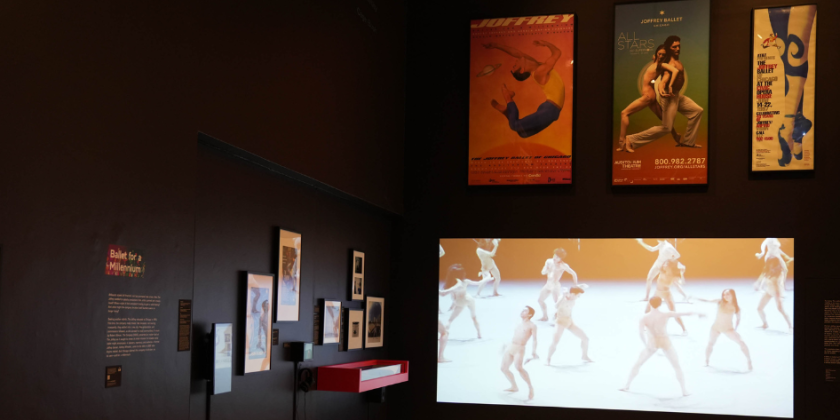A Postcard FROM The Dance Enthusiast

Dance as Empowerment Enthusiastic Event!

Dance is an ephemeral art, and “our job is to keep it alive by talking about it,” said Christine Jowers, The Dance Enthusiast’s editor-in-chief, introducing the latest in a series of Enthusiastic Events, on Tuesday, at the Gina Gibney Dance Center.

At The Dance Enthusiast, talking about dance often means writing about it, in the form of post-performance “impressions,” interviews with artists and “postcards” announcing upcoming performances. Yet it also includes the casual gab of people milling around and describing their recent dance crushes to friends, while waiters pass fanciful hors d’oeuvres at one of the festive, audience-engagement sessions the magazine has begun to host with support from the Mertz Gilmore Foundation. Acknowledging the importance of the conversations that typically take place in theater lobbies, or at nearby watering holes, these Enthusiastic Events welcome all comers encouraging both long-time fans and newbies to think of themselves as members of the dance community. And, truly, where would the dance community be without this public?

The Enthusiastic Events also expand the discussion by talking up themes related to dance. Jowers hosts these gatherings, presenting informal chats with celebrity guests accompanied by video clips and some real-live dancing. The first Enthusiastic Event, in November 2014, was dedicated to costume design, and promoted both an exhibition at the Fashion Institute of Technology and the Martha Graham Dance Company’s 2015 season. The next “Event,” on June 30, will consider improvisation, dance and the trendy phenomenon of fusion. Among the artistic guests will be Harlem dance artist, Chrybaby Cozie, the forefather of Lite Feet dancing, described as new direction of hip- hop.

Flamenco was a hot topic of discussion among the crowd on Tuesday, because the subject of the evening, “Dance as Empowerment,” included a preview of the documentary film that director and producer Lucija Stojevic is making about the legendary Spanish dancer Antonia Santiago Amador, known as “La Chana.” Exploding onto the dance scene in the 1960s, this extraordinary artist mysteriously vanished from the stage for 30 years before returning to give a farewell concert that overwhelmed with its brilliance and pathos. Flamenco performers Sonia Olla and Ismael de la Rosa Fernández were also on hand to illustrate the theme; and Jowers’ other guest was David Leventhal, a former star of the Mark Morris Dance Group who now directs a dance program for people suffering with Parkinson’s disease. Leventhal’s program is the subject of another documentary film, by David Iverson, called “Capturing Grace.”

Jowers introduced Olla and her singer-accompanist, Fernández, by describing flamenco, that intrinsically Spanish art, as another kind of conversation---one between music and dance. Then, as Fernández began his piercing song, the surroundings seemed to vanish. The modular sofa with its seated guests, the flowers and the candles all disappeared; and suddenly we were left with this young man, standing in the shadow at the edge of a small, rectangular dance floor. When Olla walked in she lunged at him, planting herself below and gazing up at him magnetized. Pulling herself up Olla seemed swollen and ready to burst, and when the energy rushed into her stamping feet viewers could feel the studio’s floor shake three yards away. The dancer trilled with her heels, and then delivered three emphatic blows---Bam! Slam! Pow!---before turning sharply to appeal to the public with arms outstretched. Fernández’s voice made her shiver, and as they continued they seemed to follow separate paths until his melody and her rhythm met at a crossroads, and they finished in perfect synchrony. Her next piece was equally impassioned. Yet after whipping desperately from side to side, Olla made a show of indifference, quieting herself and stalking out while Fernández was still singing.

“We’re really glad to be away from the computer,” Jowers said, segueing into chit-chat with her guests and introducing the film clips. Even in excerpts, “La Chana” tells the gripping story of a young woman unaccountably swept up by her talent for dancing, and just as inexplicably sidelined and then hobbled by the infirmities of old age. We hear about her as a teenager, dancing on a table at the factory where her coworkers treated her to a Coke for entertaining them. We catch a glimpse of her amazing performance in the 1967 film “The Bobo,” when she was still only 18, and we hear about the Hollywood offers she had to turn down. The film shows us her souvenirs---newspaper clippings, and black-and-white photographs cracked from years spent in a drawer. Then suddenly “La Chana” appears in color, an old lady sitting in a chair and sweating with exertion as she stamps out the rhythms she still knows by heart. Her knee crippled with arthritis, she can barely make it down a short flight of stairs. But astonishingly her dancing still crackles with energy and precision, and her life is filled with glorious music. She has lessons for the younger generation, personified by Karime Amaya in a recorded coaching session. A machine has power, “La Chana” tells us, but dancing must come from the soul. “My soul commands me to perform,” she says. “The feeling is bound to the rhythm.”

Stojevic, the director, said she’s still searching for the funds needed to complete her remarkable film. She has launched a crowd-sourcing campaign at www.indiegogo.com/projects/la-chana#home; and interested fans can follow her efforts on Twitter @LaChanaDoc.

After a clip of Leventhal performing as the goofy bird in Mark Morris’ L’Allegro, il Penseroso ed il Moderato, this group of Dance Enthusiasts watched an excerpt from David Iverson's “Capturing Grace,” where an unlikely group of dance heroes arrived for class in wheelchairs and on rolling walkers. Nothing attests to the revitalizing magic of dance like the sight of these Parkinson’s patients limping into the building, and the hopeful expressions on their faces. ( "Capturing Grace" may be pre-ordered for purchase before its official summer release at the Capturing Grace website here.)

Leventhal explained that when the Mark Morris Dance Center was about to open in 2001, Olie Westheimer, director of the Brooklyn Parkinson Group, approached the dancers with the idea of offering a special class to Parkinson’s patients. He emphasized, however, that when these individuals enter the studio they trade their identity as “patients” for that of dance students. Parkinson’s is a disease of subtraction, Leventhal said, in which people lose not only strength and coordination, but also the ability to express themselves and what he called “intentionality,” or the ability to initiate movement. The strategies that healthy dancers use to master their bodies are equally useful to Parkinson’s patients, who also benefit emotionally from the classes. While the students are still learning a modern art form, Leventhal said, there’s a sense in which these classes return dance to its roots as a community-builder. At a time in their lives when they can’t do all the things they used to do, these students “feel a sense of possibility,” he said.
Now, that’s empowering.
Check Out Trailers for The Empowering Films Discussed at our Enthusiastic Event!
La Chana Teaser from Noon Films SL on Vimeo.
Capturing Grace Trailer from Kikim Media on Vimeo.














